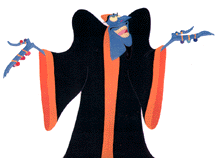The Thief and the Cobbler: A Modest Proposal

When I met former Disney animator, Art Babbit (who was responsible for the dancing mushrooms in Fantasia) towards the end of his life, he said he had only two major goals before he died: one was to set the record straight on the 1941 Disney strike and his role in it; the second was to pass on what he knew about animation to a new generation of artists. His first goal was satisfied by letting historians like myself interview him; the second was done courtesy of Richard Williams, who arranged to have him teach a series of classes at his London studio, which helped train a whole generation of British animators.
Thus, it was perhaps no surprise that, when he died on March 2, 1992, his obituaries in some British papers were bigger than those in Los Angeles, where he spent most of his professional career. One of these obits, written by Les Gibbard, told how Williams got him to, "lecture, direct and animate at his Soho Square studio. He drummed all the rules and cliches into a generation of British artists--then told them to go away and breakall the rules.
"An awesome taskmaster," Gibbard went on to say, "he enthused about the boundless horizons of a medium in its infancy: `We are barely learning to stumble on the stage . . . the pressure of `time' and `economics' have so bastardised the medium we have even forgotten how to stumble.'
"Art animated Raggedy Ann and Andy in the US for Dick Williams and, for many years, the world's longest-awaited animated feature, Williams' The Thief and the Cobbler, due to be completed shortly. Then Art Babbitt will live afresh."
However, in May, Richard Williams was fired from the film by the completion bond company and the production was given to Fred Calvert, in Hollywood, to finish. (At the time, I speculated that the production was moved from London, in part, "to avoid the wrath of the British animation community.") Calvert, who worked under the close supervision of Completion Bond Company's Betty Smith, was clearly out of his element in trying to turn Williams' wondrous comic masterpiece into a half-baked Aladdin clone, including the addition of several rather insipid musical numbers. The result, as Alex Williams notes in his review of his father's film in this issue, is something less than grand.
I really do not want to get into a game of who did what to who and why. The fact is that something needs to be done about saving what's left of the The Thief and the Cobbler. First, it is vital that steps be taken to preserve Williams' last workprint, the source of the numerous video copies floating around. This alone, even its incomplete state, would certainly be welcomed at film festivals and in a letterboxed laserdisc presentation.(After all, Disney showed a similary incomplete "work in progress edition" of Beauty and the Beast at the New York Film Festival and also released it on laserdisc.)

Beyond that, it is necessary to retrieve and preserve all the unused footage and art work produced over the some 30 years it was in production. For most of that period, The Thief and the Cobbler was mostly used as a training exercise. Thus, when Williams received full funding to finish his film in 1990, only about 10 minutes of what was to be about a 90 minute film were actually finished. This discarded material includes not only the work of Babbitt, but of such legendary masters as Ken Harris (the film's "Master Animator" who used to hang his shingle at Warner Bros.), Lantz veteran Emery Hawkins, and Betty Boop creator Grim Natwick (who was brought out of retirement to work on the film); in addition, it includes some marvelous work of such younger talents as Eric Goldberg, co-director of Disney's Pocohantas, whose animation was mostly left on the cutting room floor by Calvert and company.
In these days, when the box office returns are being dominated by the newly restored "Special Edition" of George Lucas' Star Wars trilogy, perhaps it is time that the animation community started thinking about getting involved in some serious restoration work of its own. While ASIFA-Hollywood's Adopt-a-Cartoon project is a good starting place, perhaps Disney should step in to get the ball rolling. After all, as seen in its work on Snow White and the Seven Dwarfs, it certainly has the necessary expertise to do the job right. But more importantly, through its wholly-owned Miramax subsidiary, it now owns the rights to The Thief and the Cobbler. As Miramax supposedly bought the film after all the damage was done by the Completion Bond Company, it would engender enormous good will and somewhat erase whatever stigma it might have by distributing the current version. It would also help honor the memory Art Babbitt, of one of its greatest artists, the fifth anniversary of whose death is this month.
Harvey Deneroffharvey@awn.com Editor-In-ChiefAnimation World Magazine







